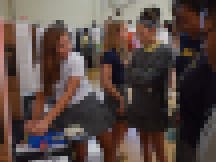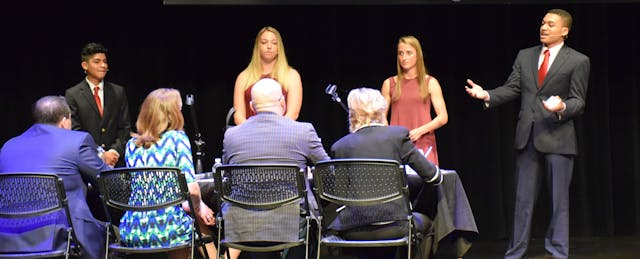Listening to Nicole’s impassioned and detailed presentation on the Puerto Rican debt crisis and its impact on the island’s healthcare system, it was easy to forget a high school senior was addressing a group of 100 students and teachers.
Nicole’s story was a personal one. She has family members on the island who deliver and receive health services, and she described her cousin’s personal struggle as a doctor who could have gone to the mainland United States to practice medicine but strongly desired to stay in his native homeland despite the economic difficulties. Nicole’s engagement and mastery of the subject matter was evident to everyone in the room as she skillfully wove together her personal story with facts, policy issues and a vivid picture of the political and economic environment of the island.
How does a school engage a senior and the entire learning community, especially in late April when seniors are close to exams and all students are grappling with spring fever and the not-too-distant target of summer? The answers are found in independent learning, deliberate community building and one very special event.
Passion Projects
Nicole’s presentation was the culmination of a yearlong in-depth study she undertook as part of a rigorous honors program for seniors, called capstone. To allow for deep dives in areas of interest for students, Bullis, a K-12 independent school in Potomac, Maryland, where I work, offers “signature” programs in four areas: entrepreneurship, humanities and global studies, STEM and visual and performing arts. Students are exposed to each of the program areas during their lower and middle school years. In Upper School, students may choose from several classes in each signature program to deepen their experience, and by senior year can enroll in one of the rigorous courses if they choose.
Each capstone student is assigned a mentor to help them pick topics, set goals and conduct their research. Our mentors are typically drawn from program directors, other faculty members and people in the community. To celebrate the learning journey of these seniors, and give them a chance to reflect on their work, Bullis hosts a Signature Program Symposium every April. It is a remarkable day! Our regular schedule is set aside to allow the entire community—students, faculty and staff, parents—to celebrate the intellectual accomplishments of our seniors.

Learning, Evolved
It’s not just the students who have undertaken a journey. Over the years, the symposium has evolved from an evening program with a small group of attendees, mostly parents, to a full-day of rotations that allow everyone to witness and honor the breadth and range of passions of these seniors. We revel in their research, discoveries, conclusions and mastery of their projects.
During the last five years, since the inception of the Bullis signature programs, we have seen an enormous growth in student capstone participation. We began with about 20 students. Now almost half the senior class, or about 70 students, choose to enroll. Why the increase? I believe it is because the program gives students a rare chance to choose how their year will proceed, both in subject area and format. They determine what they will study and how they will present their findings.
This was not always the case. When signature programs were first developed, the program directors specifically defined how students would document their learning journey and their presentations during the symposium day.
In that first year, Faith Darling, our STEM Director, required all students follow a prescriptive format on symposium day: there was a template for the powerpoint presentation and students created an accompanying science fair-like poster presentation. This year, Darling has asked students to identify the best modes of delivery for their learning based on the type of work they are doing. Thus, students who work primarily in a lab might require a different mode of presentation from those who conducted research more independently. Now they might give short TED-style talks, present a hands-on demonstration or even conduct a live experiment. Ultimately, the student must decide what format best matches his or her goals.
“When a teacher lets go of some of the control and becomes a facilitator of learning, a real mentor, students set higher goals and the work becomes more bolder,” explains Darling about the change in format. Sara Romeyn, humanities and global studies director, has taken the same approach this year for symposium day. “My overarching criteria is to ensure audience members are engaged and the mode is interactive,” she says. As the student projects have come together, at the year mid-point, they have identified their chosen presentation formats, including interactive simulations, photo exhibits, film documentaries and an art show. Performing arts students put on performances and those in the entrepreneurship program host a Shark Tank competition. “Each year, the presentations have become more varied,” she explains, “making the symposium day incredibly interesting.”

Romeyn wants audience members to learn from the presentations and also build interest in her program. In a way, symposium day is most important for freshmen and sophomores so they might visualize what their own future projects might look like. Romeyn’s students share their content findings but also much of their learning journeys. Time for audience members to ask questions is built into the schedule, and many relate to the learning journey as much as the content.
Signature symposium day has become a much-anticipated community event on the Bullis calendar. Last year, for the first time, we held a culminating event at the end of the day to specifically recognize the work of capstone students and to give closure to the day. We assembled the entire Upper School in the auditorium, awarded each student a certificate of participation and invited them on stage to be recognized by their peers—to thunderous applause.
Nicole in particular received numerous accolades from students and staff. I congratulated her for demonstrating a commitment to the people of Puerto Rico and modeling deep thinking and learning for her peers to see, and I was honored to attend an evening benefit she held at a local restaurant a few days later to raise funds for Hospital del Niño, a children’s rehabilitation hospital in San Juan. Combining her love of music and dedication to her project, Nicole performed in front of a large group of students, family and friends to purchase two life-saving defibrillators for the hospital.
Having taught Nicole as a junior, I can attest to the remarkable intellectual and personal growth I witnessed during her senior experience. Why such growth? I think it comes down to the fact that Nicole had opportunities to shape and steer her own learning in ways that made it meaningful to her. As we continue on our learning journey as a school, we anticipate continuing to personalize the learning for both capstone students, audience members and our school. It’s gives our students a chance to shine, and we know this day will serve as a peak moment for many in our community.
Lisa Vardi is is the director of cross-divisional curriculum at Bullis School in Potomac, Maryland.


